 By Hans Walltin, Walltin Building Control.
By Hans Walltin, Walltin Building Control.
Traditionally, it has been the electrical industry that has almost exclusively worked with lighting and power installations. In cases where the electrician has tackled alarm, control, multimedia and air conditioning systems, it has mainly been about installing, cable laying and connecting, while other contractors have been responsible for programming, commissioning and commissioning tests. This is despite the fact that the electrical sector has had KNX technology at its disposal for over a quarter of a century.
HVAC (Heating Ventilation and Air Conditioning) is an important part of all properties. The degree to which will depend on what climatic region the project is carried out in and whether it involves housing or various types of commercial real estate. There are different types of control system for HVAC, most of which can only manage climate and air condition devices. KNX on the other hand, is a versatile tool that can basically integrate all technical control features of a property, including HVAC.
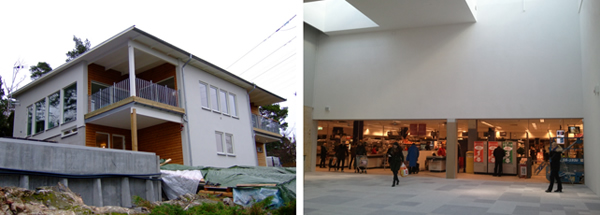
The Need for Experts
To calculate the capacity of a heat pump, a fan unit with venting ducts or an A/C unit, requires expertise that goes beyond that of which an electrical consultant or contractor may be in possession. These calculations and designs are more likely to be performed by HVAC consultants who are experts in their field. They will also be familiar with the European Standard EN15232, which sets the level of building automation and energy efficiency. In this you will find guidelines on the correct level of automation using HBES (Home and Building Electronic Systems) and BACS (Building Automation and Control Systems).
Assuming that you have the expertise required to hand, here are some tips and ideas on how to get started with your HVAC project using KNX.
Small Real Estate/Housing
Whatever the size of the building, it is highly recommended to hire HVAC experts to calculate the property’s climate system. Often it is only comfort that is considered, but it is equally important to look at the economic and environmental consequences. Small buildings and homes often have under-floor heating (UFH) or radiators installed for heating, and a local A/C split system for additional heating and cooling when needed.
Unfortunately estimates of the various HVAC systems required, in some cases do not end up being correct, often resulting in the need to add or extend different parts, post installation. The reason tends to be a desire to reduce investment costs, but perversely, this can lead to unnecessarily high operating and maintenance costs instead.
One of the keys to successful climate control is technical coordination between all input functions. For example, an original heating system may be counteracted by a retrofitted A/C split system which is meant as a supplementary heat source, but which suddenly starts to cool during a winter day with strong sunlight.
For smaller residences, I recommend a modern heat pump with heat recovery from exhaust air, possibly in combination with an A/C split unit for additional heat when necessary and cooling during hot summer periods. Just keep in mind the high energy consumption when it comes to cooling – this has a big impact on cost and the environment. Above all else, make sure they work together and not against each other! You can use KNX to keep control of the UFH or radiators through local room thermostats and valves, while the A/C split unit, if connected to KNX via infrared links or software gateways, can be dissuaded from performing any surprise manoeuvres.

Also think about installing KNX humidity sensors in vulnerable areas such as bathrooms or shower rooms in order to suppress damaging moisture levels by controlling and increasing the building’s ventilation. It will add some operating cost, but is a sound investment that will help keep your property in good health.
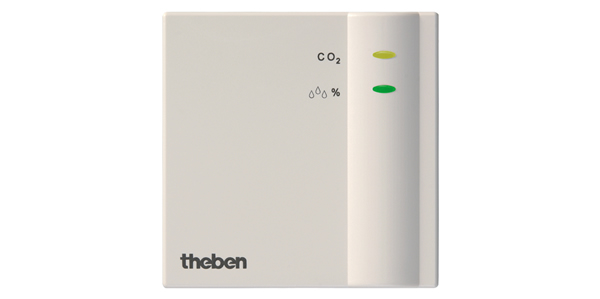
If you intend to use a heat radiator heating solution, KNX can tell the heat pump if there is someone present in the building in order to increase air flow and raise the heat. Communication between heat pumps and KNX is often made easy with relays or ModBus gateways, but some heat pumps now have KNX terminals for direct connection.
For UFH, due to the large inertia of this type of system, it is normally better to leave the setpoint where it is, and always maintain a constant temperature. Obviously this runs the risk of poorer service and higher energy costs if there are temperature shifts during the course of the day. Radiators, on the other hand, will heat and cool faster, thus providing scope for more dynamic control by increasing or decreasing the temperature in accordance with the setpoint.
Remember to document all developed calculations and estimates, so it is possible to verify the plant’s energy and cost performance in the future.
Large Real Estate
Larger buildings require some other methods to manage HVAC systems, and there are really no shortcuts to achieving good design and functionality. I strongly advise the use of skilled HVAC and electrical consultants from day one, as the proper sizing of power, flows and volumes is not something you can guess at. A truly effective way to describe the planned features of each room is to create an operation chart that shows the interactions between different system in the common space.
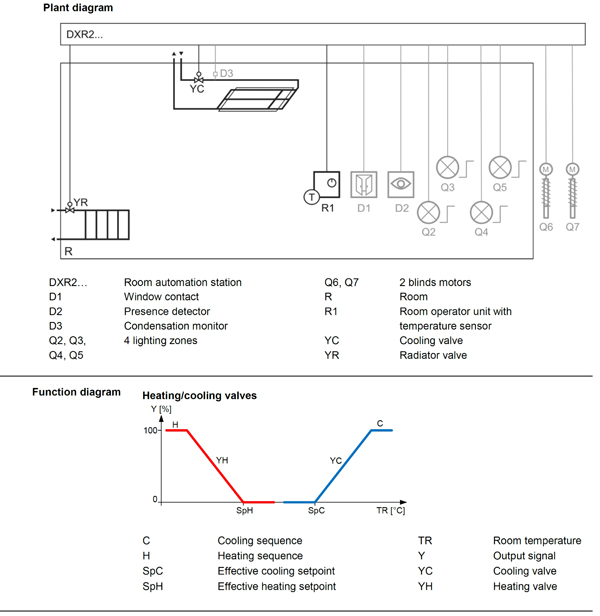
KNX can be used to control air dampers, and heating and cooling valves. Actuators and sensors are available from various manufacturers. Simpler systems such as air zoning may consist of centrally- installed air-conditioners with locally-controlled air temperature in rooms or zones using dampers and/or grilles to let in the temperate air. The central tempered air flow can be controlled in relation to the outdoor temperature or a selected point in the property. This may not be the most efficient type of regulation, but it has several economic advantages, both in deployment and operational terms.
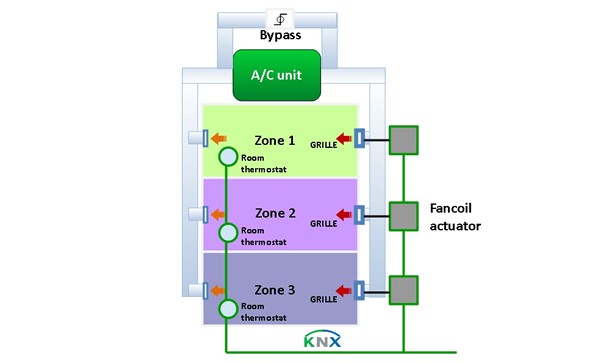
Some more advanced VRV/VRF (Variable Refrigerant Volume/Variable Refrigerant Flow) systems are based on central cooling/heating unit(s) and multiple indoor units with valves for heating and cooling, which regulate the local need right in the zone where the unit is installed.
Of course, KNX can control the indoor units individually for maximum comfort and economy. Some indoor units can be controlled with infrared links from KNX, but an increasing number of devices can, in principle, be controlled fully, using online and two-way communicating KNX gateways. It is important to consider the preferences of the master and slave functionality on the KNX and VRV/VRF panels, if you have those, when you configure the system.
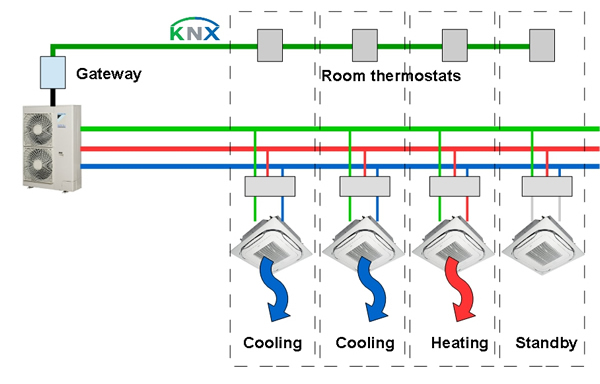
DCV (Demand Controlled Ventilation) takes into account not only the temperature but also the carbon dioxide (CO2) level for optimised fresh air flow, and may be combined with the system as above. It is an increasingly common and effective tool for regulating the fresh airflow in, for example, classrooms or conference rooms, where air quality can change rapidly and deteriorate depending on how many people are present in the room. The normal level in an empty room with basic or natural ventilation can be some 400ppm CO2. For optimal well-being, the level should not exceed 750ppm and never exceed 1000ppm CO2. KNX sensors with measurement and control of temperature, humidity and CO2 are available from several KNX manufacturers.
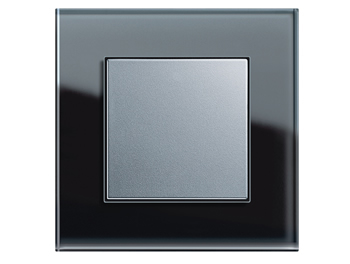
Again, it is important to document all developed calculations and computations in order to verify the plant’s energy and cost performance in the future. An HVAC operation chart (and perhaps other features) produced during the project planning should be provided to the client so that they have a clear understanding of what to expect when the property is put into operation.
Conclusion
There are many benefits to carefully planning your HVAC installation in advance. Involve the customer/user at an early stage in order to define the functions required. The technical interaction between the various system components should be done by looking at not only the current needs of the home or business, but at the possible future needs, even if the customer is unsure of what these will be.
Document all requests and proposals for the design and installation, so no doubts arise, which can lead to malfunctions and unnecessary costs later in the project. Also, take advantage of the expertise offered by electrical and HVAC consulting firms, as this will lead to suitable investments as well as operational and maintenance plans.
KNX really can handle virtually all types of HVAC, from small to very large installations, resulting in projects that are cost-effective, provide comfort, and are good for the environment. If you want to go green – go KNX!
Hans Walltin is a KNX Tutor for EUU Sweden, board member of KNX Sweden and the manager of Walltin Building Control AB.












